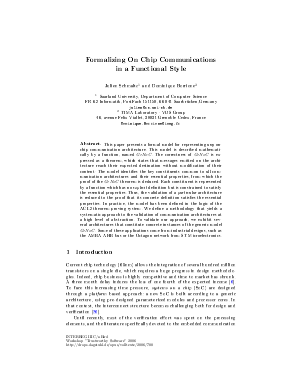Formalizing On Chip Communications in a Functional Style
Authors Julien Schmaltz, Dominique Borrione
-
Part of:
Volume:
Workshop on Trustworthy Software (TrustworthySW 2006)
Part of: Series: Open Access Series in Informatics (OASIcs) - License:
 Creative Commons Attribution-NonCommercial-NoDerivs 3.0 Unported license
Creative Commons Attribution-NonCommercial-NoDerivs 3.0 Unported license
- Publication Date: 2006-09-26
File

PDF
OASIcs.TrustworthySW.2006.700.pdf
- Filesize: 377 kB
- 25 pages
Document Identifiers
Subject Classification
Keywords
- SoC's
- communication architectures
- formal methods
- automated theorem proving
Metrics
- Access Statistics
-
Total Accesses (updated on a weekly basis)
0Document
0Metadata
Abstract
This paper presents a formal model for representing {it any} on-chip communication architecture.
This model is described mathematically by a function, named $mathit{GeNoC}$.
The correctness of $mathit{GeNoC}$ is expressed as a theorem, which states that messages emitted
on the architecture reach their expected destination without modification of their content.
The model identifies the key constituents common to {it all} communication architectures and their essential properties,
from which the proof of the $GeNoC$ theorem is deduced.
Each constituent is represented by a function which has no {it explicit} definition but is constrained
to satisfy the essential properties.
Thus, the validation of a {it particular} architecture is reduced to the proof that its concrete definition satisfies the essential properties.
In practice, the model has been defined in the logic of the ACL2 theorem proving system.
We define a methodology that yields a systematic approach to the validation of communication architectures
at a high level of abstraction. To validate our approach, we exhibit several architectures that constitute
concrete instances of the generic model $GeNoC$. Some of these applications come from industrial designs, such as
the AMBA AHB bus or the Octagon network from ST Microelectronics.
Cite As Get BibTex
Julien Schmaltz and Dominique Borrione. Formalizing On Chip Communications in a Functional Style. In Workshop on Trustworthy Software. Open Access Series in Informatics (OASIcs), Volume 3, pp. 1-25, Schloss Dagstuhl – Leibniz-Zentrum für Informatik (2006)
https://doi.org/10.4230/OASIcs.TrustworthySW.2006.700
BibTex
@InProceedings{schmaltz_et_al:OASIcs.TrustworthySW.2006.700,
author = {Schmaltz, Julien and Borrione, Dominique},
title = {{Formalizing On Chip Communications in a Functional Style}},
booktitle = {Workshop on Trustworthy Software},
pages = {1--25},
series = {Open Access Series in Informatics (OASIcs)},
ISBN = {978-3-939897-02-6},
ISSN = {2190-6807},
year = {2006},
volume = {3},
editor = {Autexier, Serge and Merz, Stephan and van der Torre, Leon and Wilhelm, Reinhard and Wolper, Pierre},
publisher = {Schloss Dagstuhl -- Leibniz-Zentrum f{\"u}r Informatik},
address = {Dagstuhl, Germany},
URL = {https://drops.dagstuhl.de/entities/document/10.4230/OASIcs.TrustworthySW.2006.700},
URN = {urn:nbn:de:0030-drops-7000},
doi = {10.4230/OASIcs.TrustworthySW.2006.700},
annote = {Keywords: SoC's, communication architectures, formal methods, automated theorem proving}
}
